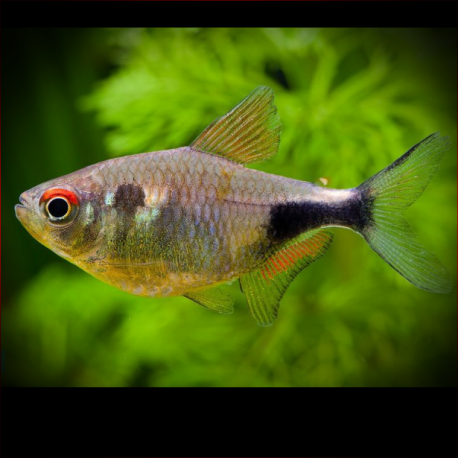More info
Datasheet
| Minimum Tank Size | 70 litres / 18.49 US gallons |
| Maximum Size | 4.5cm / 1.77inches |
| Temperature | 23°C / 73.40°F - 27°C / 80.60°F |
| Hardness | 1-12ºdH |
| pH | 5.5-7.0 |
General Description
The Hemigrammus Pulcher, commonly known as the Pretty Tetra, garnet, or black wedge tetra, is a popular and hardy species in the aquarium hobby. Belonging to the Characidae family, this tetra species grows up to 4.5 cm in size and is endemic to the slow-moving tributaries of the Upper Amazon in Peru. Its taxonomy is under the genus Hemigrammus, which houses over 70 small characin species, hinting towards a need for taxonomic revision.
Aquarium Setup
Adaptable to captive environments, the Pretty Tetra thrives in most tanks but stands out in heavily planted setups. For optimal display, a biotope tank mimicking its natural habitat with river sand substrate, driftwood, dried leaves for coloring the water, and a bit of peat in the filter for black water conditions is recommended. Dim lighting further enhances the aesthetic appeal of this species within the tank (see table for specific water conditions).
Behaviour
This tetra species is known for its lively and colorful nature, making it an ideal community tank member. It demonstrates peaceful behavior and thrives alongside various tankmates like livebearers, danios, rasboras, other tetras, and peaceful bottom dwellers such as Corydoras or smaller Loricariids. Being a shoaling species by instinct, it is advisable to keep the Pretty Tetra in groups of at least 6, preferably more, to promote its well-being and natural shoaling behavior.
Feeding and Diet
Easy to feed, the Pretty Tetra readily accepts a diverse diet, including small live and frozen foods like bloodworms, Daphnia, and brine shrimp, along with dried flakes and granules. For optimal health and coloration, regular meals of varied food types are recommended to meet its nutritional requirements.
Reproduction & Dimorphism
Reproduction of the Pretty Tetra can be achieved in a separate breeding tank with specific conditions. Sexing is possible by examining the swim bladder, which differs between males and females. The female is usually larger and more heavy-bodied. Successful breeding entails providing a dimly lit environment with appropriate vegetation for egg deposition. The adults should be removed post-spawning to prevent egg consumption, with fry requiring delicate care and feeding on infusoria initially.
Habitat and Distribution
Found mainly in the slow-moving tributaries of the Upper Amazon in Peru, the Pretty Tetra is primarily sourced from commercial farms in Eastern Europe for the aquarium trade. Its natural habitat comprises forest-covered waters, making it crucial to replicate similar conditions in captivity to ensure the species' well-being.

